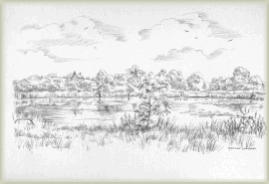



Wellow Village | Nottinghamshire

Wellow Dam
Origins and history
The
earliest
reference
to
Wellow
Dam
in
documents
is
in
the
reckoning
of
"Landes
and
cottages
within
the
Lordship
of
Welley
in
the
County
of
Nottingham,
belonging
to
the
Honorable
Sir
George
Savile,
Barron,
taken
in
the
latter
ends
of
August
in
the
year
of
our
Lord
1657",
and
the
earliest
map
showing
the
dam
is
dated 1738.
It
is,
however,
widely
believed
to
be
much
older,
and
to
have
gone
back
much
closer
to
the
origins
of
Wellow
itself,
around
1145AD,
and
a
variety
of
theories
exist
on
its
purpose.
Although
these
theories
must
largely
be
conjecture,
they
are
examined here, so that the reader may form his or her own judgements.
The
Dam
is
man
-
made,
and
would
therefore
have
been
dug
out
with
one
or
more
specific
purposes
in
mind
-
we
don't
know
whether
the
original
excavation
was
the
same
size
as
now,
or
whether
it
was
made
bigger
over
time.
But
it
certainly was not made for fun, and would have taken a considerable amount of hard work to complete.
Legend
has
it
that
the
Dam
was
made
by
the
monks
of
Rufford
as
a
fish
pond;
given
that
it
is
a
long
way
from
the
Abbey,
and
that
they
already
had
plenty
of
scope
for
fish
stocks
there
,
this
doesn't
seem
too
likely
-
particularly
when
you
consider
that
the
stocked
pond
would
be
much
closer
to
the
fishermen
of
Wellow
than
the
monks!
But
remembering
that
the
village
grew
up
from
the
ex
-
settlers
of
Rufford
and
Cratley,
it
is
not
impossible
that
the
men
of
Wellow
made
it
with
fish in mind (although that might not have been the prime purpose).
It
might
have
been
excavated
for
the
clay;
given
that
the
early
dwellings
in
the
village
would
have
been
made
of
mud
and
clay,
there
would
have
been
a
ready
source
there
for
the
early
houses,
or,
later,
to
be
used
to
make
bricks.
The
amount
of
clay
coming
from
the
Dams'
present
size
would
have
been
far
too
much,
though,
for
the
original
size
of
the
village.
But
to
state
the
obvious,whoever
begun
the
first
excavation,
did
so
deliberately
in
the
path
of
a
stream,
in
the
knowledge
that
the
hole
they
made
would
fill
with
water.
If
the
only
purpose
had
been
to
get
at
the
clay,
presumably
the
hole
could
have
been
dug
somewhere
a
little
drier!.
So
the
theory
that
the
purpose
was
for
a
water
supply
for
the
settlers
is
also
valid.
More
likely,
perhaps,
that
there
was
a
dual
need,
for
water,
and
for
clay,
and
that
this
spot
met
both;
perhaps
with
the
later
addition
of
a
supply
of
fresh
fish.
It
is
likely,
too,
that
the
original
dam
was
much
smaller,
and
was
expanded
over
time.
This
still
does
not
help
us
with
a
date,
and
despite
best
efforts,
none
has
been
forthcoming.
So
somewhere
between
1145AD and 1657AD is the answer - and this is, admittedly, a very wide window of probability.
Looking
at
Wellow
through
the
ages,
there
are
times
when
it
is
possible
to
see
a
very
distinct
advantage
in
having
that
water
source,
outside
the
village,
and
independent
of
the
(plentiful)
water
supply
within
it.
It
would
be
particularly
beneficial
to
be
able
to
water
stock
there,
not
only
locally-owned
livestock,
but
also
the
travelling
animals
on
the
way
to
market,
and
passing
through
Wellow
because
of
the
village's
position
on
an
important
main
road.
Perhaps
the
livestock
stayed overnight, whilst their keepers sampled the delights of Wellow's numerous pubs, and brought trade to the village.
So
although
the
origins
are
still
a
mystery,
we
can
be
sure
that
over
the
centuries,
the
dam
has
provided
practical
benefits,
but
also
fun
and
recreation.
We
know
this
for
the
20th
century
-
why
should
it
not
be
so
in
earlier
times?
Children, despite hard times, would hopefully have had some time to play.
Records
show
that
in
1928,
the
then
Lord
of
the
Manor
gave
his
permission
for
the
dam
to
be
let
out
to
a
fishing
club,
and
he
waived
his
rights
to
the
income
from
this,
on
condition
that
Toftholders
used
the
fees
to
maintain
the
banks
and
the
greens.
But
he
stipulated
that
this
should
not
interfere
with
the
rights
of
local
children
to
enjoy
the
water.
And
it
is
clear
from
the
memories
we
publish
in
this
booklet,
that
they
certainly
did
that!
The
fact
that
so
many
memories
revolve
around
skating
on
the
dam
brings
home
how
much
more
severe
the
winters
must
have
been
then
-
the
water
is
hardly
ever frozen these days, and then not thickly enough to make the ice safe.
And
what
an
evocative
memory
of
the
plough
horses,
after
a
hard
days'
work
in
the
fields,
having
their
legs
washed
and
splashing around in the cool water.
So
the
Wellow
Dam
is
just
as
much
a
piece
of
history
as
any
fine
building
or
statue
-
and
much
more
useful;
we
should
be glad we have it.



The Wellow Village History Website















